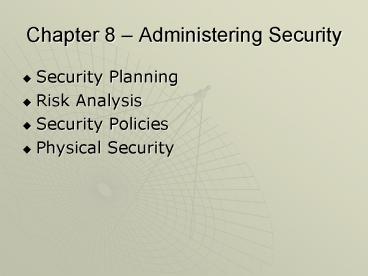Chapter 8 - PowerPoint PPT Presentation
Title:
Chapter 8
Description:
Chapter 8 Administering Security Security Planning Risk Analysis Security Policies Physical Security Security Planning Policy Current state risk analysis ... – PowerPoint PPT presentation
Number of Views:46
Avg rating:3.0/5.0
Title: Chapter 8
1
Chapter 8 Administering Security
- Security Planning
- Risk Analysis
- Security Policies
- Physical Security
2
Security Planning
- Policy
- Current state risk analysis
- Requirements
- Recommended controls
- Accountability
- Timetable
- Continuing attention
3
Security Planning - Policy
- Who should be allowed access?
- To what system and organizational resources
should access be allowed? - What types of access should each user be allowed
for each resource?
4
Security Planning - Policy
- What are the organizations goals on security?
- Where does the responsibility for security lie?
- What is the organizations commitment to security?
5
OCTAVE Methodologyhttp//www.cert.org/octave/
- Identify enterprise knowledge.
- Identify operational area knowledge.
- Identify staff knowledge.
- Establish security requirements.
- Map high-priority information assests to
information infrastructure. - Perform an infrastructure vulnerability
evaluation. - Conduct a multidimensional risk analysis.
- Develop a protection strategy.
6
Security Planning Requirements of the TCSEC
- Security Policy must be an explicit and
well-defined security policy enforced by the
system. - Every subject must be uniquely and convincingly
identified. - Every object must be associated with a label that
indicates its security level. - The system must maintain complete, secure records
of actions that affect security. - The computing system must contain mechanisms that
enforce security. - The mechanisms that implement security must be
protected against unauthorized change.
7
Security Planning Team Members
- Computer hardware group
- System administrators
- Systems programmers
- Application programmers
- Data entry personnel
- Physical security personnel
- Representative users
8
Security Planning
- Assuring Commitment to a Security Plan
- Business Continuity Plans
- Assess Business Impact
- Develop Strategy
- Develop Plan
- Incident Response Plans
- Advance Planning
- Response Team
- After the Incident is Resolved
9
Risk Analysis
- Risk impact - loss associated with an event
- risk probability likelihood that the event will
occur - Risk control degree to which we can change the
outcome - Risk exposure risk impact risk probability
10
Risk Analysis risk reduction
- Avoid the risk
- Transfer the risk
- Assume the risk
- Risk leverage (risk exposure before reduction)
(risk exposure after reduction) / cost of risk
reduction - Cannot guarantee systems are risk free
- Security plans must address action needed should
an unexpected risk becomes a problem
11
Steps of a Risk Analysis
- Identify assets
- Determine vulnerabilities
- Estimate likelihood of exploitation
- Compute expected annual loss
- Survey applicable controls and their costs
- Project annual savings of control
12
Identify Assets
- Hardware
- Software
- Data
- People
- Procedures (policies, training)
- Documentation
- Supplies
- Infrastructure (building, power, water,)
13
Determine Vulnerabilities
Asset Confidentiality Integrity Availability
Hardware
Software
Data
People
procedures
14
Determine Vulnerabilities
- What are the effects of unintentional errors?
- What are the effects of willfully malicious
insiders? - What are the effects of outsiders?
- What are the effects of natural and physical
disasters?
15
Risk Analysis
- Estimate Likelihood of Exploitation
- Classical probability
- Frequency probability (simulation)
- Subjective probability (Delphi approach)
- Computer Expected Lost (look for hidden costs)
- Legal obligations
- Side effects
- Psychological effects
16
Risk Analysis
- Survey and Select New Controls
- What Criteria Are Used for Selecting Controls?
- Vulnerability Assessment and Mitigation (VAM)
Methodology - How Do Controls Affect What They Control?
- Which Controls Are Best?
- Project Savings
- Do costs outweigh benefits of preventing /
mitigating risks
17
Arguments for Risk Analysis
- Improve awareness
- Relate security mission to management objectives
- Identify assets, vulnerabilities, and controls
- Improve basis for decisions
- Justify expenditures for security
18
Arguments against Risk Analysis
- False sense of precision and confidence
- Hard to perform
- Immutability (filed and forgotten)
- Lack of accuracy
- Todays complex Internet networks cannot be made
watertight. A system administrator has to get
everything right all the time a hacker only has
to find one small hole. A sysadmin has to be
lucky all of the time a hacker only has to get
lucky once. It is easier to destroy than to
create. - Robert Graham, lead architect of Internet
Security Systems
19
Organizational Security Policies
- Who can access which resources in what manner?
- Security policy - high-level management document
that informs all users of the goals and
constraints on using a system.
20
Security Policies Purpose
- Recognize sensitive information assets
- Clarify security responsibilities
- Promote awareness for existing employees
- Guide new employees
21
Security Policies Audience
- Users
- Owners
- Beneficiaries
- Balance Among All Parties
22
Contents
- Purpose
- Protected Resources (what - asset list)
- Nature of the Protection (who and how)
23
Characteristics of a Good Security Policy
- Coverage (comprehensive)
- Durability
- Realism
- Usefulness
- Examples
24
Physical Security
- Natural Disasters
- Flood
- Fire
- Other
- Power Loss
- UPS surge suppressors (line conditioners)
- Human Vandals
- Unauthorized Access and Use
- Theft
25
Physical Security
- Interception of Sensitive Information
- Dumpster Diving - Shredding
- Remanence (slack bits)
- Overwriting Magnetic Data
- DiskWipe
- Degaussing
- Emanation - Tempest
26
Contingency Planning
- BACKUP!!!!!
- Complete backup
- Revolving backup
- Selective backup
- OFFSITE BACKUP!!!!!
- Networked Storage (SAN)
- Cold site (shell)
- Hot site































